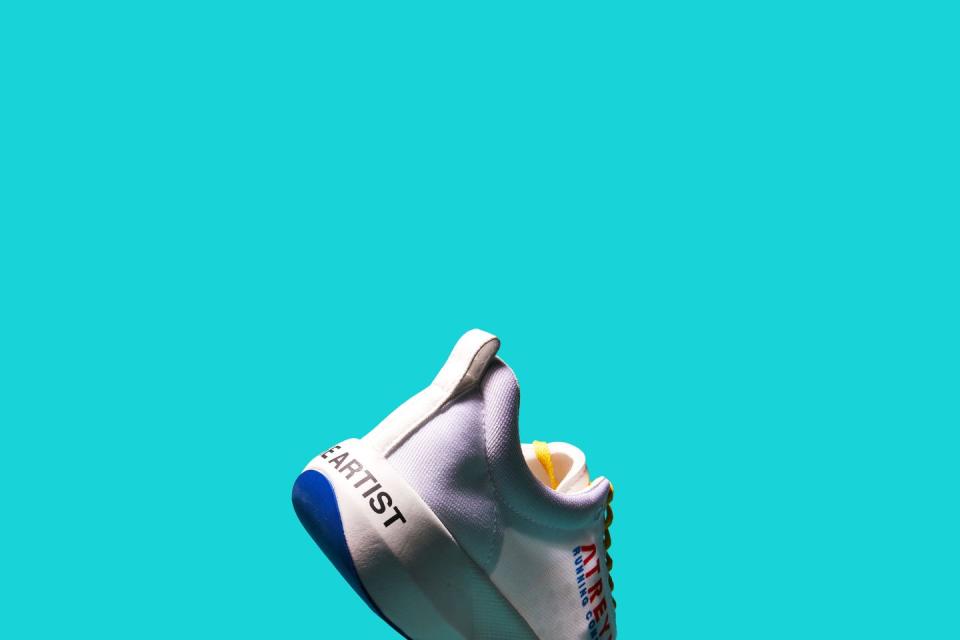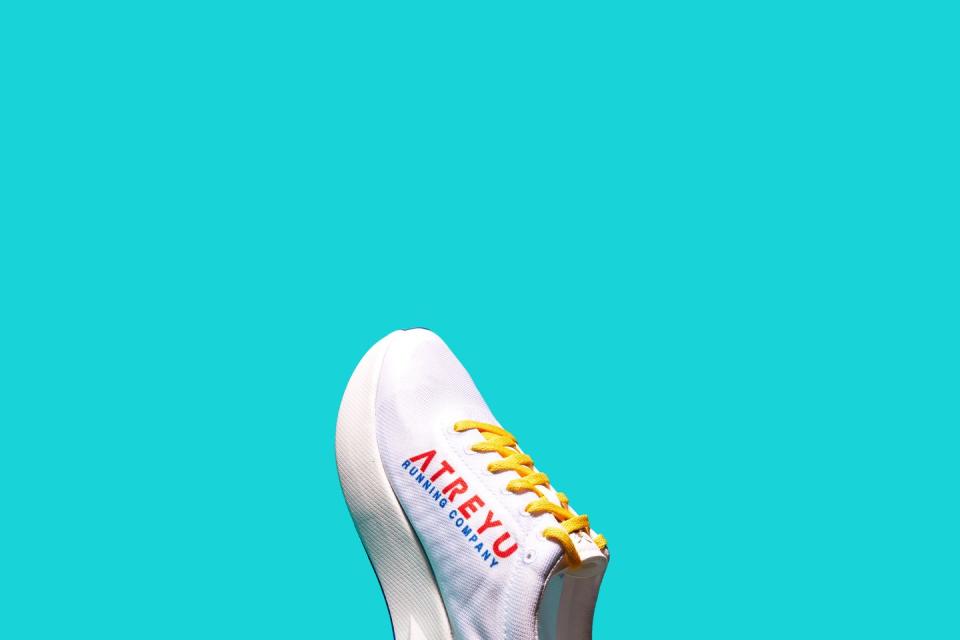Atreyu The Artist: This Exciting New Carbon Fiber-Plated Shoe Costs Just $100

“Hearst Magazines and Verizon Media may earn commission or revenue on some items through the links below.”
The RW Takeaway: A bargain racer from a newcomer that is competitive with more established companies.
An EVA midsole helps keep costs down.
A carbon-fiber plate stiffens the sole and makes toe-off feel snappy.
Available online only.
Price: $100 (pre-order)
Weight: 7.3 oz. (unisex)
Drop: 6 mm
Type: Road
One hundred dollars for a lightweight racer with a carbon-fiber plate? Crazy. So is starting a shoe company in 2020, but that’s just what founder Michael Krajicek did. And, since he didn’t come to his gig the way a lot of shoe company pioneers do—through retail—he’s taken a new approach to slinging shoes: a subscription model. Commit to buying a pair of Atreyu every month (or every three months) and they’ll cost you a fraction of what you’d pay for shoes from other brands.
Atreyu’s first model was a $55 racing flat that was too thin and firm for most of our testers. But this follow-up is a thicker shoe that boosts comfort and speed. It uses supercritical EVA—not the pricier, bouncier Pebax you’ll find in Nike’s Vaporfly Next%—sandwiched around a curved carbon-fiber plate. Don’t let that deter you: The sole is slightly squishy when you land heel-first, but firm and snappy when you push off the ground.
The treadless rubber outsole closely resembles the one used on the Adidas Adizero Adios Pro, but the shoe doesn’t feel quite as fast as that speed racer. Then again, it’s half the price.
A New Take on EVA
New foams are garnering all the headlines in footwear right now. Every brand is working with compounds like Pebax, TPU, and TPE, though many shoes still leverage some formulation of ethylene-vinyl acetate (EVA), the white stuff found in the soles of running shoes for decades. EVA remains prevalent because it has an excellent marriage of weight, durability, and impact attenuation, at a low cost. Those newer compounds, however, are bouncier and more protective—and in cases like Pebax, even lighter. EVA isn’t dead, but it is changing in some cases.
The Artist uses a newer manufacturing method for shoes called “supercritical.” We’ve seen this process used in the full range of Skechers shoes that feature Hyperburst midsoles, where a fluid has been heated and pressurized to a point that it can actually penetrate solid blocks of plastic (EVA) to change the cell structure of the resulting foam. In the case of the foam in the Artist, Atreyu is using a liquified EVA, not a hard plastic shoe-shaped puck. The CO2 and EVA are injected into molds in a more traditional fashion to form the midsole shape. The result is similar, in any case, in that the foam offers great cushioning-to-weight ratio yet remains durable.
It’s still not a squishy soft experience like you’d get in the Vaporfly or in a bouncy shoe with Boost, but it’s also not a harsh, jarring experience like you’d find in a typical racing flat.

A Stiff Sole
As you can imagine by looking at the profile of this shoe, it doesn’t bend. There’s a lot of foam—more than an inch—along with a rigid carbon-fiber plate you can’t see. That slopes from under the heel and curves down under the forefoot, setting up a snappy heel-to-toe transition. But, even with that inflexible sole, the shoe doesn’t feel exceptionally stiff underfoot. That’s mostly because of the shape, which is curved but not a true rocker like you’ll find on a Hoka One One. But, the sole tapers under the toes and curves upward at an extreme angle, so you roll more smoothly through toe-off.
Thin, Grippy Rubber
Look at a Formula 1 car or a motorcycle on the track and you’ll notice that both have slick tires. That actually improves traction and performance on paved surfaces. The same thing happens under the Artist. It’s not a shoe you’re going to lace up on trails or where you’d need tread, but our test team was genuinely shocked at how well it gripped in a variety of situations.

“I thought the flat rubber sole would be prone to slipping,” said Pat Heine, RW’s video producer, “but that wasn’t the case. I gripped even on wet or slick surfaces like painted lines on the road or smooth cobblestone sidewalks.”
The layer of rubber is only 1mm thick, so don’t expect crazy durability, but our test team noted that it held up well for the month-long test session. In real-world usage, you’d likely wear it less than we did, reserving it for fastest efforts and race days, so durability should be no concern.
Built for Blacktop
On a hot summer day, your feet can take a beating. These white shoes will keep you cooler, thanks to the breezy upper. Our test team found it exceptionally cold during a test session in winter weather, as wind goes right through the mesh. In warmer conditions, it breathes well when you’re working hard.

The one-piece mesh upper fits comfortably well and stretches just a bit to accommodate different foot sizes. But a saddle bonded to the inside of the midfoot mesh controls that stretch so that you get a locked-in fit where you need it most. Wide, flat laces and a lightly padded tongue made with micro-felt boosts comfort when you cinch the shoe tight.
You Might Also Like

